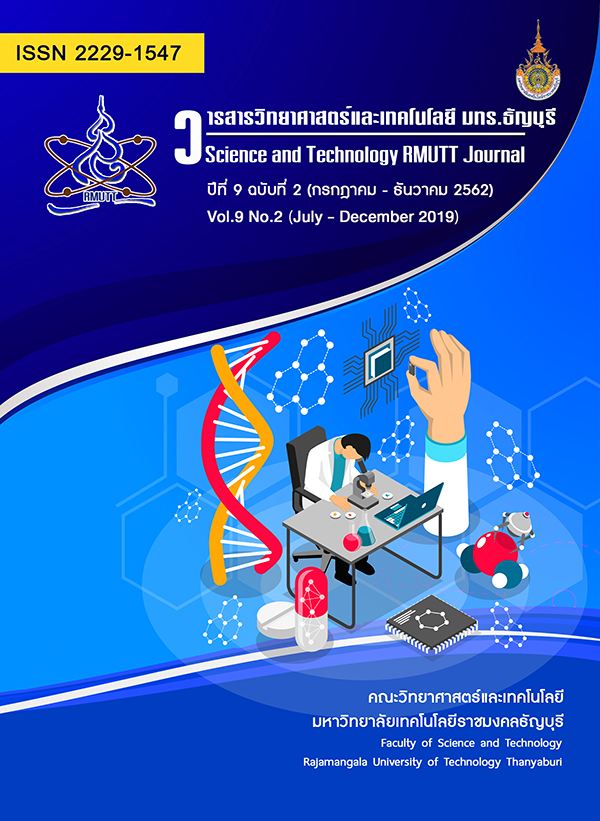Formulation of plant extracts for some pathogenic bacteria inhibition
Main Article Content
Abstract
Medicinal plants could be an alternative treatment for non-infectious and infectious diseases, especially bacterial skin infections. This study selected 16 plant extracts and prepared 16 recipes to determine anti-bacterial activity by agar disc diffusion method. Primary results of anti-bacterial activity showed inhibitory activity from formulation number 3 (Bengal-Currants), 12 (Betel) and 15 (Galangal) which was significantly different from those of other formulations at p<0.05. Then, the three mixture extracts were prepared for 4 formulas namely formulation 17, 18, 19 and 20. Anti-bacterial activity of these 4 recipes were determined by agar disc diffusion method. The results showed that all of them gave an anti-bacterial activity against Staphylococcus aureus and Escherichia coli. However, after observation at 48 h., only formula 18 completely inhibited tested bacteria around the disc. Formula 18 was selected to investigate the minimum inhibitory concentration (MIC) and minimum bactericidal concentration (MBC) values against representative bacterial stains by broth microdilution method. The MIC/MBC values for S. aureus E. coli and MRSA as 0.62/0.62, 2.5/5.0 and 0.31/0.31 mg/ml, respectively. Taken together, this study provide evidence that formulations of extract mixture from Bengal-Currants, Betel, and Galangal, has antibacterial activity. These formulations should be developed to control pathogenic bacteria.
Article Details
References
Misic A. M., Gardner S. E., and Grice E. A. The wound microbiome: modern approaches to examining the role of microorganisms in impaired chronic wound healing. Advances in Wound Care. 2014. 3(7) : 502-510.
Kazimoto T., Abdulla S., Bategereza L., Juma O., Mhimbira F., Weisser M., Utzinger J., von Müller L. and Becker S. L. Causative agents and antimicrobial resistance patterns of human skin and soft tissue infections in Bagamoyo, Tanzania. Acta Tropica, 2018. 186 : 102-106.
Zaki M.E.S., Bastawy S. and Montasser K. Molecular study of resistance of Staphylococcus aureus to antiseptic quaternary ammonium compounds. Journal of Global Antimicrobial Resistance. 2019. 17 : 94-97.
Malik T. A., Kamili A. N., Chishti M. Z., Ahad S., Tantry M. A., Hussain P. R. and Johri R. K. Breaking the resistance of Escherichia coli: Antimicrobial activity of Berberis lycium Royle. Microbial Pathogenesis. 2017. 102 : 12-20.
de Souza Cândido E., de Barros E., Cardoso M. H. and Franco O. L. Bacterial cross-resistance to anti-infective compounds. Is it a real problem?. Current Opinion in Pharmacology. 2019. 48 : 76-81.
Visutthi M. Anti-staphylococcal screening of selected Thai medicinal plants from Nakhon Ratchasima province. Suranaree Journal of Science and Technology. 2016. 23(2) : 109-114.
Visutthi, M. Anti-bacterial and Anti-quorum Sensing Properties of Selected Medicinal Plants from Nakhon Ratchasima Province, Thailand. Science and Technology RMUTT Journal. 2016. 6(1) : 1-13.
Temrangsee P., Kondo S. and Itharat A. Antibacterial activity of extracts from five medicinal plants and their formula against bacteria that cause chronic wound infection. Journal of the Medical Association of Thailand. 2011. 94 : 166-171.
Chokpaisarn J., Yincharoen K., Sanpinit S., Pandian S. T. K., Nandhini J. R., Gowrishankar S., Limsuwan S., Kunworarath N., Voravuthikunchai S.P. and Chusri, S. Effects of a traditional Thai polyherbal medicine ‘Ya-Samarn-Phlae’ as a natural anti-biofilm agent against Pseudomonas aeruginosa. Microbial Pathogenesis. 2019. 128 : 354-362.
มณฑล วิสุทธิ. ฤทธิ์ต้านแบคทีเรียกลุ่ม Staphylococci ของพืชท้องถิ่นบางชนิดในนครราชสีมา. วารสารวิทยาศาสตร์ มข. 2560. 45(4) : 805-816.
Srinivasan R., Santhakumari S. and Ravi A. V. In vitro antibiofilm efficacy of Piper betle against quorum sensing mediated biofilm formation of luminescent Vibrio harveyi. Microbial Pathogenesis. 2017. 110 : 232-239.
Teanpaisan R., Kawsud P., Pahumunto N., and Puripattanavong J. Screening for antibacterial and antibiofilm activity in Thai medicinal plant extracts against oral microorganisms. Journal of Traditional and Complementary Medicine. 2017. 7(2) : 172-177.
Basak S., and Guha P. Betel leaf (Piper betle L.) essential oil microemulsion: Characterization and antifungal activity on growth, and apparent lag time of Aspergillus flavus in tomato paste. LWT. 2017. 75 : 616-623.
Pecková R., Doležal K., Sak B., Květoňová D., Kváč M., Nurcahyo W. and Foitová I. Effect of Piper betle on Giardia intestinalis infection in vivo. Experimental Parasitology. 2018. 184 : 39-45.
Karak S., Acharya J., Begum S., Mazumdar I., Kundu R. and De B. Essential oil of Piper betle L. leaves: Chemical composition, anti-acetylcholinesterase, anti-β-glucuronidase and cytotoxic properties. Journal of Applied Research on Medicinal and Aromatic Plants. 2018. 10 : 85-92.
Rao K., Ch B., Narasu L. M. and Giri A. Antibacterial activity of Alpinia galanga (L) Willd crude extracts. Applied Biochemistry and Biotechnology. 2010. 162(3) : 871-884.
Tang X., Xu C., Yagiz Y., Simonne A. and Marshall M. R. Phytochemical profiles, and antimicrobial and antioxidant activities of greater galangal [Alpinia galanga (Linn.) Swartz.] flowers. Food Chemistry. 2018. 255 : 300-308.
Singh D., Kumar V., Yadav E., Falls N., Singh M., Komal U. and Verma A. One-pot green synthesis and structural characterization of silver nanoparticles using aqueous leaves extract of Carissa carandas: antioxidant, anticancer and antibacterial activities. IET Nanobiotechnology. 2018. 12(6) : 748-756.
Aman S., Naim A., Siddiqi R. and Naz S. Antimicrobial polyphenols from small tropical fruits, tea and spice oilseeds. Food Science and Technology International. 2014. 20(4) : 241-251.


